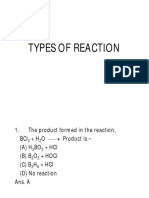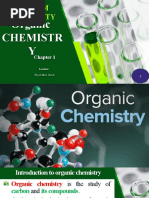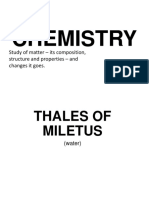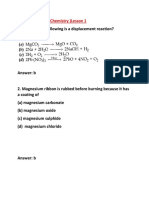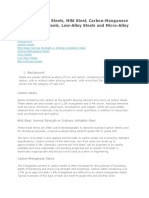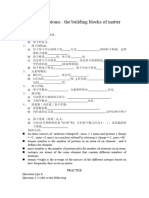DPP-1 POC - Combined
DPP-1 POC - Combined
Uploaded by
Pranav ChauhanCopyright:
Available Formats
DPP-1 POC - Combined
DPP-1 POC - Combined
Uploaded by
Pranav ChauhanOriginal Title
Copyright
Available Formats
Share this document
Did you find this document useful?
Is this content inappropriate?
Copyright:
Available Formats
DPP-1 POC - Combined
DPP-1 POC - Combined
Uploaded by
Pranav ChauhanCopyright:
Available Formats
Practical Organic Chemistry
Practical Organic Chemistry DPP-01
1. When one mole of the given compound reacts with sodium metal, how many moles of H 2
gas will be released?
O
OH (1mole)
(A) 1 mole
(B) 1.5 mole
(C) 2 mole
(D) 0.5 mole
BR2/H2O
Positive test
2. Baeyer’s reagent
C4H6 Positive test
(X) Na metal
Positive test
Compound X is:
(A) H3C–CC–CH3
(B) CH2=CH–CH=CH2
(C) CH3–CH2–CCH
CCH
(D)
3. Which one of the following will not give positive test with Br2/H2O?
(A) Cyclohexene
(B) Cyclohexane
(C) Ethene
(D) Acetylene
4. Which of the following test, could be performed to distinguish between 1-Butyne and 2-
Butyne ?
(A) AgNO3 + NH4OH
(B) Br2 / CCI4
(C) H2 / Pt
(D) dil.KMnO4
Digital [1]
Practical Organic Chemistry
5. Lucas reagent is:
(A) anhydrous CaCl2 and conc. HCl
(B) anhydrous ZnCl2 and conc. HCl
(C) anhydrous AlCl3 and conc. HCl
(D) anhydrous PdCl2 and conc. HCl
6. Which of the following can be used to distinguish between 1º, 2º & 3º alcohols ?
(A) Lucas test
(B) Iodoform test
(C) 2,4-DNP test
(D)Baeyer's reagent
1. Red P + I2
7. Unknown alcohol 2. AgNO3
blue colour
3. HNO2
4. NaOH
The unknown alcohol can be -
(A) (CH3)2CHOH
(B) CH3CH2OH
CH3
(C) Ph C CH3
OH
(D) CH2=CH–CH2OH
8. Which of the following compounds decolourise Br2/H2O and also give positive test with
neutral FeCl3?
(A)
OH
(B)
(C) OH
(D) OH
9. Among the following one that gives positive iodoform test on reaction with 2 and NaOH is ?
(A) CH3CH2CH(OH)CH2CH3
(B) C6H5CH2CH2OH
(C) CH3 CH CH3
CH2–OH
(D) PhCHOHCH3
Digital [2]
Practical Organic Chemistry
10. Which of the following compound liberate CO2 gas when treated with NaHCO3 ?
(A) Acetophenone
(B) Oxalic acid
(C) Acetamide
(D) Styrene
11. Which of the following compound on heating with NaOH makes phenolphthalein pink
colour disappear?
(A) Benzoic acid
(B) Methyl formate
(C) Benzophenone
(D) Acetaldehyde
12. Which of the following can be used to differentiate between Pentan-2-one & Pentan-3-one
?
(A) Iodoform test
(B) 2,4-Dinitrophenyl hydrazine
(C) Fehling solution
(D) Tollen's reagent
13. Unknown compound (A) C5H10O gives positive test with 2,4-DNP but negative test with
Tollen's reagent. It also give yellow precipitate with I2/NaOH. (A) is :
H
(A)
O
O
(B)
O
(C)
H
(D)
O
OH OH
COOH COOCH3
14. and can be differentiated by :
(A) NaOH
(B) Na metal
(C) NaHCO3
(D) FeCl3
Digital [3]
Practical Organic Chemistry
15. Which of the following cannot be used to distinguish between aldehyde & ketones ?
(A) Tollen’s reagent
(B) Fehling’s test
(C) Benedicts test
(D) 2, 4-Dinitrophenyl hydrazine
O O
16. CH3 – C – H and Ph – C – H can be differentiated by :
(A) Tollen's reagent
(B) Fehling's solution
(C) Lucas reagent
(D) Victor meyer's test
17. Acetic acid and ethyl amine can be differentiated by :
(A) Carbyl amines test
(B) Iodoform test
(C) Cold KMnO4
(D) Br2/H2O
18. Which of the following compounds will give a positive iodoform test ?
(A) Methanol
(B) 2,3-Dimethyl butanol
(C) Ethyl alcohol
(D) Methanal
19. Which of the following acid gives positive Tollen's test ?
(A) Acetic acid
(B) Benzoic acid
(C) Formic acid
(D) Succinic acid
20. Carbon and hydrogen in organic compounds are detected by heating compound with :
(A) FeO
(B) CaO
(C) CuO
(D) MnO
21. Lassaigne's test is not used for the detection of :
(A) Nitrogen
(B) Sulphur
(C) Chlorine
(D) Oxygen
Digital [4]
Practical Organic Chemistry
22. During the fusion of an organic compound with sodium metal, nitrogen of the organic
compound is converted into :
(A) NaNO2
(B) NaNH2
(C) NaCN
(D) NaNC
23. The compound formed in the positive test for nitrogen with the Lassaigne's solution of an
organic compound is :
(A) Fe4(Fe(CN)6]
(B) Na4[Fe(CN)6]
(C) Fe(CN)2
(D) Na4 [Fe(CN)5NOS]
24. Acidified sodium fusion extract on addition of ferric chloride solution gives red colouration
which confirm the presence of :
(A) Sulphur and chlorine
(B) Nitrogen and sulphur
(C) Only nitrogen
(D) Only sulphur
25. The lassaigne's extract is boiled with concentrated HNO3 before testing for halogen because :
(A) AgCN is soluble is HNO3
(B) Silver halide are soluble HNO3
(C) NaCN and Na2S are decomposed by HNO3
(D) Ag2S is soluble in HNO3
26. Ammonium molybdate is used for detection of which element in organic compound ?
(A) Carbon
(B) Nitrogen
(C) Phosphorus
(D) Sulphur
27. Yellow precipitate in the detection of phosphorus when an organic compound is heated with
Na2O2 and then boiled with con. HNO3 followed by the addition of ammonium molybdate is
due to the formation of :
(A) (NH4)3PO4.12 MoO3
(B) (NH4)3PO4.6MoO3
(C) (NH4)3 PO4.12 MoO2
(D) (NH4)3 PO4.6MoO2
Digital [5]
Practical Organic Chemistry
28. An organic compound which produces a bluish green coloured flame on heating in the
presence of copper is :
(A) Benzyl chloride
(B) Benzaldehyde
(C) Aniline
(D) Benzoic acid
NH2 NH2
29. and can be differentiated by :
(A) carbylamine reaction
(B) Ph–SO2Cl
(C) diazotisation followed by -naphthol
(D) mustard oil reaction
NH2
30. and can be differentiated by :
(A) FeCl3
(B) NaOH
(C) CS2/HgCl2
(D) Fehling's solution
31. A white solid 'X' give following chemical test :
(i) it liberates CO2 with NaHCO3
(ii) it form a coloured dye on diazotisation reaction followed by coupling with -naphthol
'X' can be identified as :
NH2 NH2
(A) (B)
CH3
COOH
NHCOCH3
NH2
(C) (D)
OH
COOH
Digital [6]
Practical Organic Chemistry
Answer Key
Question 1 2 3 4 5 6 7 8 9 10 11 12 13 14 15
Answer D C B A B A A D D B B A B C D
Question 16 17 18 19 20 21 22 23 24 25 26 27 28 29 30
Answer B A C C C D C A B C C A A C C
Question 31
Answer B
Digital [7]
Practical Organic Chemistry
Solutions DPP – 1
1. Ans. (D)
𝟏
No. of moles of H2 gas = × Number of acidic hydrogen.
𝟐
2. Ans. (C)
BR2/H2O
Positive test =/ bond
Baeyer’s reagent
C4H6 Positive test =/ bond
(X) Na metal
Positive test acidic H
3. Ans. (B)
Unsaturated compound gives positive test with Br2/ H2O. Cyclohexane is saturated compound.
4. Ans. (A)
Terminal alkyne (1-butyne) gives white ppt. with Tollen's reagent.
5. Ans. (B)
Lucas reagent is anhydrous ZnCl2 and conc. HCl
6. Ans. (A)
Lucas test (conc. HCl & anhydrous ZnCl2) can distinguish 1°, 2° & 3° alcohol on the basis of the time
required for turbidity to appear.
7. Ans. (A)
It is victor meyer test. Secondary alcohol gives blue colour.
8. Ans. (D)
Phenol gives positive test with neutral FeCl3 and decolourise Br2/H2O solution.
9. Ans. (D)
For positive iodoform test, alcohol molecules must have CH3 CH group
OH
I2 + NaOH
Ph CH CH3 CHI3 + Ph – COO–
OH
10. Ans. (B)
Carboxylic acid (Oxalic acid) react with NaHCO3 and liberate CO2 gas.
11. Ans. (B)
Ester (Methyl formate) on heating with NaOH makes phenolphthalein pink colour disappear.
Digital [8]
Practical Organic Chemistry
12. Ans. (A)
Pentan-2-one gives both iodoform test while Pentan-3-one does not give iodoform test.
13. Ans. (B)
O
gives both iodoform test and 2-4-DNP test but not gives Tollen’s test.
14. Ans. (C)
OH
COOH
liberate CO2 gas when treated with NaHCO3.
15. Ans. (D)
2, 4-DNP cannot be used to distinguish between aldehyde & ketones since both of them show this
reaction.
16. Ans. (B)
Aromatic aldehyde (Ph–CHO) do not give Fehling’s solution test.
17. Ans. (A)
Ethyl amine (1° amines) gives Carbyl amine test.
18. Ans. (C)
Ethyl alcohol gives positive iodoform test.
19. Ans. (C)
Formic acid is the only acid which positive Tollen's test.
20. Ans. (C)
C + 2CuO
2Cu + CO2
H2 + CuO Cu + H2O
21. Ans. (D)
Lassaigne's test is used for the detection of Nitrogen, Sulphur and Halogen.
22. Ans. (C)
Na + C + N NaCN
Digital [9]
Practical Organic Chemistry
23. Ans. (A)
6NaCN + FeSO4 Na4[Fe(CN)6]
Na4[Fe(CN)6] + 4Fe3+ Fe4[Fe(CN)6]3
Ferric ferrocyanide (Prussian blue)
24. Ans. (B)
Na + C + N + S NaSCN
Neutral FeCl3 + NaSCN Fe(SCN)3 (Blood red)
25. Ans. (C)
If nitrogen or sulphur is also present in the compound, the sodium fusion extract is first boiled with
concentrated nitric acid to decompose cyanide or sulphide of sodium formed during Lassaigne’s
test. These ions would otherwise interfere with silver nitrate test for halogens.
NaCN + HNO3 → NaNO3 + HCN
Na2S + 2HNO3 → 2NaNO3 + H2S
26. Ans. (C)
Ammonium molybdate is used for detection of Phosphorus.
27. Ans. (A)
2P + 5Na2O2 2Na3PO4 + 2Na2O
Na3PO4 + 3HNO3 H3PO4 + 3NaNO3
H3PO4 + 12(NH4)2MoO4 + 21HNO3 (NH4)3PO4. 12MoO3 + 21NH4NO3 + 12H2O
(ammonium phospho molybdate)
28. Ans. (A)
Halogen containing compound (Benzyl chloride) produces a bluish green coloured flame on
heating in the presence of copper.
29. Ans. (C)
Aromatic amine gives positive diazotisation test.
30. Ans. (C)
Aniline gives Hoffman’s mustard oil test.
31. Ans. (B)
Aromatic amine on diazotisation reaction followed by coupling with -naphthol gives orange red
dye and carboxylic acid liberates CO2 with NaHCO3.
Digital [10]
You might also like
- Principle Related To Practical ChemistryDocument11 pagesPrinciple Related To Practical ChemistryEzhil MukilNo ratings yet
- Home Assignment-3Document32 pagesHome Assignment-3ansh guptaNo ratings yet
- Poc 17.06.06 VaDocument3 pagesPoc 17.06.06 Valkj1234No ratings yet
- Iit Questions On Carbonyl Compounds & Carboxylic Acid and Its DerivativeDocument12 pagesIit Questions On Carbonyl Compounds & Carboxylic Acid and Its DerivativeRaju SinghNo ratings yet
- Without Answer (86-89) POCDocument7 pagesWithout Answer (86-89) POCmohantadipayan08No ratings yet
- Class-10-Chemical Reactions and Equations-QuizDocument2 pagesClass-10-Chemical Reactions and Equations-QuizIX17-41 Suvayu ChatterjeeNo ratings yet
- 3 - Aldehydes and Ketones (Assignment) Booklet-2Document15 pages3 - Aldehydes and Ketones (Assignment) Booklet-2kraken monster100% (1)
- Carbonyl Compounds 12thDocument24 pagesCarbonyl Compounds 12thRaju SinghNo ratings yet
- Jee 2014 Booklet7 HWT Oxygen Containing Organic Compounds IIDocument10 pagesJee 2014 Booklet7 HWT Oxygen Containing Organic Compounds IIvarunkohliinNo ratings yet
- KCET Chemistry (2024)Document8 pagesKCET Chemistry (2024)hamdanmd2403No ratings yet
- Chemistry 2nd Year Eamcet Named Reaction Identification of Functional Group-1Document7 pagesChemistry 2nd Year Eamcet Named Reaction Identification of Functional Group-1Surya Charan Reddy100% (1)
- Quiz Organic 1Document6 pagesQuiz Organic 1ronakgupta332005No ratings yet
- Nitrogen CompoundsDocument11 pagesNitrogen CompoundsJatindra PatelNo ratings yet
- Kcet - Chemistry - 2019: Version Code: D-5Document7 pagesKcet - Chemistry - 2019: Version Code: D-5Manoj CNo ratings yet
- Ots-4 (Kohinoor) TestDocument9 pagesOts-4 (Kohinoor) Testatharvatelang178No ratings yet
- Practical Ortanic Chemistry - QuestionDocument9 pagesPractical Ortanic Chemistry - Questionaryaraajmalhotra855No ratings yet
- Question Bank Class Xii (Chemistry) Unit 5: Alcohols, Phenols & Ethers Multiple Choice QuestionsDocument21 pagesQuestion Bank Class Xii (Chemistry) Unit 5: Alcohols, Phenols & Ethers Multiple Choice QuestionsSahilNo ratings yet
- Daily Practice Problems (DPPS) : Organic ChemistryDocument12 pagesDaily Practice Problems (DPPS) : Organic ChemistrySiddhantNo ratings yet
- Aromatic Compounds (13th)Document24 pagesAromatic Compounds (13th)Raju SinghNo ratings yet
- Aromatic CompoundsDocument16 pagesAromatic CompoundsadityaNo ratings yet
- MPP 3 Oc RCC-20200921163955648374Document7 pagesMPP 3 Oc RCC-20200921163955648374amanshahabas57No ratings yet
- Aldehydes and Ketones - 3Document6 pagesAldehydes and Ketones - 3iitlectureNo ratings yet
- MHT-CET 2016: Chemistry - Actual Test Paper: (Solution at The End)Document10 pagesMHT-CET 2016: Chemistry - Actual Test Paper: (Solution at The End)SushantNo ratings yet
- Practice TestDocument14 pagesPractice TestHimanshu JindalNo ratings yet
- CHEMISTRY-11-03 - (12th & 13) (POI) Paper-1Document12 pagesCHEMISTRY-11-03 - (12th & 13) (POI) Paper-1Raju SinghNo ratings yet
- Carbonyl CompoundDocument197 pagesCarbonyl CompoundAmitNo ratings yet
- Aldehydes, Ketones and Carboxylic AcidsDocument7 pagesAldehydes, Ketones and Carboxylic Acidskavitha2511977No ratings yet
- Alcohols, Phenols & Ether - Practice SheetDocument4 pagesAlcohols, Phenols & Ether - Practice SheetsrikantadonikaNo ratings yet
- Notes Chapter 882Document107 pagesNotes Chapter 882notime ReactionNo ratings yet
- Alcohols & EthersDocument36 pagesAlcohols & EthersKaveesh KulkarniNo ratings yet
- Extra Practice Module - Alcohol Ether PhenolDocument8 pagesExtra Practice Module - Alcohol Ether PhenolUtkarsh HarshNo ratings yet
- cadDocument32 pagescadveertambi29No ratings yet
- Aldehydes & KetonesDocument23 pagesAldehydes & KetonesManthan JhaNo ratings yet
- Halogen Derivatives PDFDocument32 pagesHalogen Derivatives PDFRaju Singh100% (1)
- C25 CHEMISTRY Practice Sheet - POC Part-2Document8 pagesC25 CHEMISTRY Practice Sheet - POC Part-2shravanibendale887No ratings yet
- KCET 2019 Question Paper ChemistryDocument7 pagesKCET 2019 Question Paper ChemistryDarshan LNo ratings yet
- Time: 1 Hrs Max. Marks: 98 Single Correct: 3 2 4 HG ZNDocument6 pagesTime: 1 Hrs Max. Marks: 98 Single Correct: 3 2 4 HG ZNlakshmi.vedanarayanan7785No ratings yet
- CH 12 Aldehydes, Ketones and Carboxylic AcidsDocument70 pagesCH 12 Aldehydes, Ketones and Carboxylic Acidsqs5cj2h49wNo ratings yet
- Sheet - 01 - Carbonyl Compound Exercise Sheet NJ - 247Document62 pagesSheet - 01 - Carbonyl Compound Exercise Sheet NJ - 247priyanshumodak525No ratings yet
- Carbonyl Compounds SheetDocument133 pagesCarbonyl Compounds Sheetadityavaish739No ratings yet
- Corbonyl CompOUND AND Corboxilic AcidDocument12 pagesCorbonyl CompOUND AND Corboxilic AcidApex InstituteNo ratings yet
- 12TH CBSE DPP 37. Aldehydes, Ketones and Carboxylic Acids MCQ ASSERTION REASON CS QDocument20 pages12TH CBSE DPP 37. Aldehydes, Ketones and Carboxylic Acids MCQ ASSERTION REASON CS Q123No ratings yet
- Class Test-1-Aldehydes & Ketones - PreparationDocument5 pagesClass Test-1-Aldehydes & Ketones - PreparationSarthak VermaNo ratings yet
- Chem Lab Compre CompiledDocument6 pagesChem Lab Compre Compiledpragyan singhNo ratings yet
- Alcohol & Ether B Lord of The RingsDocument13 pagesAlcohol & Ether B Lord of The RingsadityaNo ratings yet
- Ic DPP 15Document10 pagesIc DPP 15Sai VedantNo ratings yet
- Aldehydes, Ketones and Carboxylic Acids MCQ Assertion-3Document5 pagesAldehydes, Ketones and Carboxylic Acids MCQ Assertion-3bullet4478No ratings yet
- Unit 11 MCQDocument7 pagesUnit 11 MCQJay VermaNo ratings yet
- MCQ - D04 Oct 2024Document13 pagesMCQ - D04 Oct 2024anzarsiddiqui128No ratings yet
- scribd 5Document5 pagesscribd 5chatfawadNo ratings yet
- Carboxylic Acid CPPDocument24 pagesCarboxylic Acid CPPGulshan kumarNo ratings yet
- KCET Chemistry (2024)Document8 pagesKCET Chemistry (2024)chemistry1to9No ratings yet
- JEE Advanced Aldehyde and Ketones Important QuestionsDocument23 pagesJEE Advanced Aldehyde and Ketones Important QuestionsthisissubhaNo ratings yet
- Unittest - D19 Nov 2024Document9 pagesUnittest - D19 Nov 2024Dhaval KatariyaNo ratings yet
- HydrogenandS BlocksheetDocument23 pagesHydrogenandS Blocksheetsureshserious7226No ratings yet
- Diwali Assignment 12thDocument19 pagesDiwali Assignment 12thNishantPlayz YtNo ratings yet
- GujCET - D26 Mar 2023Document34 pagesGujCET - D26 Mar 2023aadityabhagchandaniNo ratings yet
- Chemistry-Part Test-4Document8 pagesChemistry-Part Test-4Raju SinghNo ratings yet
- Structural Identification and POC - QP.for Crash CourseDocument24 pagesStructural Identification and POC - QP.for Crash Courseelangovan n.jNo ratings yet
- Chemistry Answers IgcseDocument10 pagesChemistry Answers IgcseD AnithaNo ratings yet
- A-Level Chemistry AssignmentDocument10 pagesA-Level Chemistry AssignmentLevy MulengaNo ratings yet
- Introduction To Organic Chemistry-1Document18 pagesIntroduction To Organic Chemistry-1Abdulahi Muse OsmanNo ratings yet
- Atomic Structure - The Periodic Table 2 QPDocument13 pagesAtomic Structure - The Periodic Table 2 QPAbirame SivakaranNo ratings yet
- Bab IiDocument8 pagesBab Iibeni firiyaNo ratings yet
- DOC316.53.01219 8ed PDFDocument46 pagesDOC316.53.01219 8ed PDFRonal Urdaneta ChacinNo ratings yet
- CHAPTER 3: Fundamental Laws of Chemistry, States of MatterDocument52 pagesCHAPTER 3: Fundamental Laws of Chemistry, States of MatterMASHNo ratings yet
- Fusion ProcDocument26 pagesFusion Procdip_maanNo ratings yet
- Catalogo Flexmasters PDFDocument21 pagesCatalogo Flexmasters PDFAnonymous 6VCG1YRdNo ratings yet
- Auralite Robert SimmonsDocument2 pagesAuralite Robert Simmonsnikanor1100% (1)
- Oxygen FamilyDocument2 pagesOxygen FamilyLisoo Man (Emilca)No ratings yet
- Nuclear Chem Sample QuestionsDocument2 pagesNuclear Chem Sample QuestionsMichael Robert Gatdula SamarNo ratings yet
- Apch231 EdtaDocument13 pagesApch231 EdtaTan Ze KaiNo ratings yet
- Identifying Ions PracDocument5 pagesIdentifying Ions PracLora DelphieNo ratings yet
- G0K - G12-2023-SIMSO-Science-National Round-Answer KeyDocument4 pagesG0K - G12-2023-SIMSO-Science-National Round-Answer KeymokonoaniNo ratings yet
- Chapter 3 - Chemical CalculationsDocument40 pagesChapter 3 - Chemical CalculationsAhmedAmer1100% (1)
- Wadi Cement Work Ordinary Portland Cement 53 Grade: Chemical CharacteristicsDocument1 pageWadi Cement Work Ordinary Portland Cement 53 Grade: Chemical CharacteristicsAshish SontakkeNo ratings yet
- Chem Class 10 Term 1 MCQ S & ARDocument78 pagesChem Class 10 Term 1 MCQ S & ARINDHRA VARMANo ratings yet
- Study Material Class 10 Chapter 2 2017 PDFDocument12 pagesStudy Material Class 10 Chapter 2 2017 PDFKaran Pratap100% (6)
- Steels - Carbon Steels, Mild Steel, Carbon-Manganese Steels, Alloys Steels, Low-Alloy Steels and Micro-Alloy SteelsDocument2 pagesSteels - Carbon Steels, Mild Steel, Carbon-Manganese Steels, Alloys Steels, Low-Alloy Steels and Micro-Alloy SteelsHoangNo ratings yet
- A 1008 - A 1008M - Steel Sheets Improved Formeability-16Document10 pagesA 1008 - A 1008M - Steel Sheets Improved Formeability-16Ahmed SalehNo ratings yet
- Ka TableDocument2 pagesKa TableMuhammad AimanNo ratings yet
- 2RM Cb2ans eDocument94 pages2RM Cb2ans eTat LNo ratings yet
- Nama Nama Unsur: Nama Latin Nama Unsur Simbol No Atom Massa Atom Relatif Golongan PeriodeDocument3 pagesNama Nama Unsur: Nama Latin Nama Unsur Simbol No Atom Massa Atom Relatif Golongan PeriodeizhariNo ratings yet
- Stainless Steel From JindalDocument35 pagesStainless Steel From Jindalrajbir_singhNo ratings yet
- Instrumental Chemistry For Engineers (CHE515) : Prepared byDocument31 pagesInstrumental Chemistry For Engineers (CHE515) : Prepared byJohan Aliff100% (1)
- 02 Atoms The Building Blocks of MatterDocument2 pages02 Atoms The Building Blocks of MatterspengappNo ratings yet
- SFF 2022 Activity Benedicts TestDocument4 pagesSFF 2022 Activity Benedicts TestTALHA MONDAL (my.selftalha)No ratings yet
- Elastomeric Impression MaterialsDocument6 pagesElastomeric Impression MaterialsMarlene CasayuranNo ratings yet
- oSIST prEN 17685 1 2021Document10 pagesoSIST prEN 17685 1 2021Salma ElrayahNo ratings yet




























